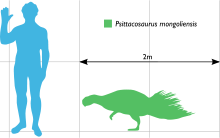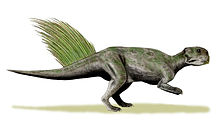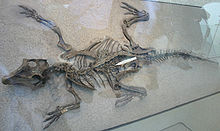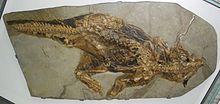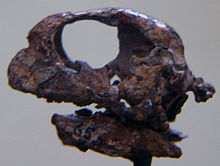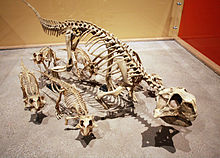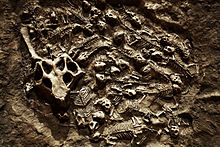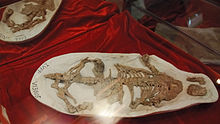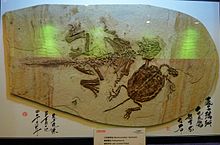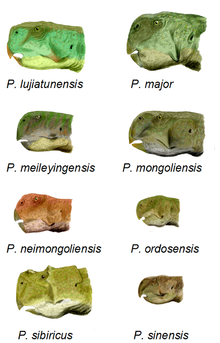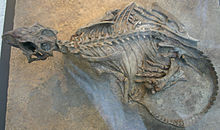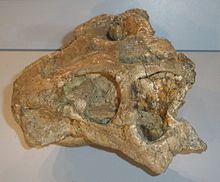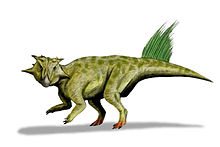
Psittacosaurus
About this schools Wikipedia selection
SOS Children produced this website for schools as well as this video website about Africa. SOS Child sponsorship is cool!
| Psittacosaurus Temporal range: Early Cretaceous, 130–100Ma |
|
|---|---|
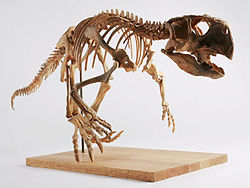 |
|
| P. meileyingensis cast, Childrens Museum of Indianapolis | |
| Scientific classification |
|
| Kingdom: | Animalia |
| Phylum: | Chordata |
| Class: | Reptilia |
| Order: | †Ornithischia |
| Suborder: | †Ceratopsia |
| Family: | †Psittacosauridae |
| Genus: | †Psittacosaurus Osborn, 1923 |
| Type species | |
| Psittacosaurus mongoliensis Osborn, 1923 |
|
| Species | |
|
Species of Psittacosaurus
|
|
| Synonyms | |
|
Protiguanodon |
|
Psittacosaurus (pron.: / ˌ s ɪ t ə k ə ˈ s ɔr ə s / SIT-ə-kə-SOR-əs; from the Greek for "parrot lizard") is a genus of psittacosaurid ceratopsian dinosaur from the Early Cretaceous Period of what is now Asia, about 130 to 100 million years ago. It is notable for being the most species-rich dinosaur genus. Nine to eleven species are recognized from fossils found in different regions of modern-day China, Mongolia and Russia, with a possible additional species from Thailand.
All species of Psittacosaurus were gazelle-sized bipedal herbivores characterized by a high, powerful beak on the upper jaw. At least one species had long, quill-like structures on its tail and lower back, possibly serving a display function. Psittacosaurs were extremely early ceratopsians. Although they developed many novel adaptations, they shared many anatomical features with later ceratopsians such as Protoceratops and Triceratops.
Psittacosaurus is not as familiar to the general public as its distant relative Triceratops but it is one of the most completely known dinosaur genera. Fossils of over 400 individuals have been collected so far, including many complete skeletons. Most different age classes are represented, from hatchling through to adult, which has allowed several detailed studies of Psittacosaurus growth rates and reproductive biology. The abundance of this dinosaur in the fossil record has led to the creation of the Psittacosaurus biochron for Lower Cretaceous sediments of east Asia.
Description
Different species of Psittacosaurus varied in size and specific features of the skull and skeleton, but shared the same overall body shape. The best-known species, P. mongoliensis, reached 2 meters (6.5 ft) in length. The maximum adult body weight was most likely over 20 kilograms (44 lb) in P. mongoliensis. Several species approached P. mongoliensis in size (P. major, P. neimongoliensis, P. xinjiangensis), while others were somewhat smaller (P. sinensis, P. meileyingensis). P. ordosensis was the smallest known species, 30% smaller than P. mongoliensis. The largest were P. lujiatunensis and P. sibiricus, although neither was significantly larger than P. mongoliensis.
The skull of Psittacosaurus was highly modified compared to other ornithischian dinosaurs of its time. The skull was extremely tall in height and short in length, with an almost round profile in some species. The portion in front of the orbit (eye socket) was only 40% of total skull length, shorter than any other known ornithischian. The lower jaws of psittacosaurs are characterized by a bulbous vertical ridge down the centre of each tooth. Both upper and lower jaws sported a pronounced beak, formed from the rostral and predentary bones, respectively. The bony core of the beak may have been sheathed in keratin to provide a sharp cutting surface for cropping plant material. As the generic name suggests, the short skull and beak superficially resembled those of modern parrots. Psittacosaurus skulls shared several adaptations with more derived ceratopsians, such as the unique rostral bone at the tip of the upper jaw, and the flared jugal (cheek) bones. There was still no sign of the bony neck frill or prominent facial horns which would develop in later ceratopsians. Bony horns did protrude from the skull of P. sibiricus, but these are thought to be an example of convergent evolution.
Psittacosaurus postcranial skeletons were more typical of a 'generic' bipedal ornithischian. In P. mongoliensis, similarly to other species, the forelimbs were only 58% as long as the hindlimbs and their range of motion indicates that the hands could neither be rotated at the forearm ( pronated) nor used in scrambling fashion, to generate propulsive force, suggesting that these animals were totally bipedal in life. There were only four digits on the manus ('hand'), as opposed to the five found in most other ornithischians (including all other ceratopsians). Overall, the four-toed hindfoot was very similar to many other small ornithischians.
Paleobiology
Daily activity patterns
Comparisons between the scleral rings of Psittacosaurus and modern birds and reptiles suggest that it may have been cathemeral, active throughout the day and night at short intervals.
Diet
Psittacosaurs had self-sharpening teeth that would have been useful for cropping and slicing tough plant material. Unlike later ceratopsians, they did not have teeth suitable for grinding or chewing their food. Instead, they used gastroliths, stones swallowed to wear down food as it passed through the digestive system. Gastroliths, sometimes numbering more than fifty, are occasionally found in the abdominal cavities of psittacosaurs, and may have been stored in a gizzard, as in modern birds.
Unlike many other dinosaurs, psittacosaurs had akinetic skulls: that is to say, the upper and lower jaws each behaved as a single unit, without internal joints. The only joint was the jaw joint itself, and psittacosaurs could slide their lower jaws forward and backward on the joint, permitting a shearing action. Unlike most ceratopsians, their beaks did not form curved tips, but were instead rounded and flattened. If the jaws were aligned, the beaks could be used to crop objects, but if the lower jaw was retracted so that the lower beak was inside the upper beak, the jaws may have served a nutcracking function. A nut- or seed-rich diet would also match well with the gastroliths often seen in well-preserved psittacosaur skeletons.
Integument
The integument, or body covering, of Psittacosaurus is known from a Chinese specimen, which most likely comes from the Yixian Formation of Liaoning. The specimen, which is not yet assigned to any particular species, was illegally exported from China, in violation of Chinese law, but was purchased by a German museum and arrangements are being made to return the specimen to China.
Most of the body was covered in scales. Larger scales were arranged in irregular patterns, with numerous smaller scales occupying the spaces between them, similarly to skin impressions known from other ceratopsians, such as Chasmosaurus. A series of what appear to be hollow, tubular bristles, approximately 16 centimeters (6.4 in) long, were also preserved, arranged in a row down the dorsal (upper) surface of the tail. According to some scientists. "at present, there is no convincing evidence which shows these structures to be homologous to the structurally different feathers and protofeathers of theropod dinosaurs." As the structures are only found in a single row on the tail, it is unlikely that they were used for thermoregulation, but they may have been useful for communication through some sort of display.
Growth rate
Several juvenile Psittacosaurus have been found. The smallest is a P. mongoliensis hatchling conserved in the American Museum of Natural History (AMNH), which is only 11 to 13 centimeters (4–5 inches) long, with a skull 2.8 centimeters (1 in) in length. Another hatchling skull at the AMNH is only 4.6 centimeters (1.8 inches) long. Both specimens are from Mongolia. Juveniles discovered in the Yixian Formation are approximately the same age as the larger AMNH specimen. Adult Psittacosaurus mongoliensis approached 2 meters (6.5 ft) in length.
A histological examination of P. mongoliensis has determined the growth rate of these animals. The smallest specimens in the study were estimated at three years old and less than 1 kilogram (2.2 lb), while the largest were nine years old and weighed almost 20 kilograms (44 lb). This indicates relatively rapid growth compared to most reptiles and marsupial mammals, but slower than modern birds and placental mammals. An age determination study performed on the fossilized remains of Psittacosaurus mongoliensis by using growth ring counts suggest that the longevity of the basal ceratopsian was 10 to 11 years.
Limb function
Studies by Phil Senter in 2007 conducted on Psittacosaurus neimongoliensis and Psittacosaurus mongoliensis concluded that the forelimbs of these taxa (and likely those of other Psittacosaurus species) were too short to reach the ground and could neither be pronated nor generate propulsive force for locomotion, suggesting that Psittacosaurus was entirely bipedal. The forelimbs were also too short to be used in digging or bringing food to the mouth, and Senter suggested that if Psittacosaurus needed to dig depressions in the ground it may have used its hindlimbs instead. The forelimbs could be used for two-handed grasping of objects or scratching the body, but due to their extremely limited flexibility and reach, they could have only been used to grasp objects very close to the belly or sides of the animal and could have scratched only the belly, flank and knees. Even though the hands could not reach the mouth, Psittacosaurus could have still used them to carry nesting material or food to a desired location.
Parental care and gregariousness
An extremely well preserved specimen found in the Yixian Formation of Liaoning Province, China provides some of the best evidence for parental care in dinosaurs. This specimen consists of an adult Psittacosaurus (not assigned to any particular species), which is closely associated with 34 articulated juvenile skeletons, all preserved in three dimensions. The young Psittacosaurus, all approximately the same age, are intertwined in a group underneath the adult, although all 34 skulls are positioned above the mass of bodies, as they would have been in life. This suggests that the animals were alive at the time of burial, which must have been extremely rapid, perhaps due to the collapse of a burrow.
The juvenile bones are very small but are well- ossified. This has been taken as evidence of extensive parental care, as the young must have been in the nest long enough for their bones to become ossified. A separate find of a herd of six Psittacosaurus individuals killed by a volcanic mudflow indicates the presence of at least two age groups from two distinct clutches. This find has been taken as evidence for group fidelity and gregariousness extending beyond the nest; the earliest such evidence for any ceratopsian. Even very young psittacosaur teeth appear worn, indicating they chewed their own food and may have been precocial, although this does not rule out continued parental care.
Possible aquatic behaviour
Ford and Martin (2010) proposed that Psittacosaurus was semi-aquatic, swimming with its tail like a crocodile, and paddling and kicking. They based their interpretation on evidence including: the lacustrine (lake) depositional setting of many specimens; the position of the nostrils and eyes; interpretations of the motions of the arms and legs; tails with long chevrons (and with the bristles on the tail interpreted as possibly skin-covered, forming a fin), providing a propulsive surface; and the presence of gastroliths, interpreted as ballast. They further suggested that some species of Psittacosaurus were more terrestrial than others.
Predation
Another fossil from the Yixian Formation provides direct evidence of Psittacosaurus as a prey animal. One skeleton of Repenomamus robustus, a large triconodont mammal, is preserved with the remains of a juvenile Psittacosaurus in its abdominal cavity. Several of the juvenile's bones are still articulated, indicating that the carnivorous mammal swallowed its prey in large chunks. This specimen is notable in that it is the first known example of Mesozoic mammals preying on live dinosaurs. Heavy predation on juvenile Psittacosaurus may have resulted in R-selection, the production of more numerous offspring to counteract this loss.
Pathology
Out of over 400 known Psittacosaurus specimens, only one has been published with any sort of pathology. The specimen in question, consisting of a complete adult skeleton and tentatively assigned to P. mongoliensis, was found in the lower beds of the Yixian Formation. There is no sign of a bone fracture, but very clear signs of an infection can be seen near the midpoint of the right fibula. The bone exhibits a large round pit, evidence of necrosis due to a lack of blood supply to the region. The pit is surrounded by a massive amount of swelling along the lower third of the bone. This large amount of bone deposited around the injury indicates that the animal survived for quite a while despite the injury and subsequent infection. As psittacosaurids were bipedal animals, a similar injury to a weight bearing bone in the leg would likely have been fatal. Unlike the femur and tibia, the fibula is not a weight-bearing bone, so this animal would still have been able to walk to some extent. The source of the injury remains unknown.
Provenance
Psittacosaurus is known from over 400 individual specimens, of which over 75 have been assigned to the type species, P. mongoliensis. All Psittacosaurus fossils discovered so far have been found in Early Cretaceous sediments in Asia, from southern Siberia to northern China, or possibly as far south as Thailand. The most common age of geologic formations bearing Psittacosaurus fossils is from the late Barremian through Albian stages of the Early Cretaceous, or approximately 125 to 100 Ma ( million years ago). Many terrestrial sedimentary formations of this age in Mongolia and northern China have produced fossils of Psittacosaurus, leading its use as in defining the Psittacosaurus biochron for this time period in the region.
The earliest known species is P. lujiatunensis, found in the lowest beds of the Yixian Formation. Over 200 specimens attributed to this genus have been recovered from these and other beds of the Yixian, the age of which is the subject of much debate. Although many early studies using radiometric dating put the Yixian in the Jurassic Period, tens of millions of years outside of the expected temporal range of Psittacosaurus, most recent work dates it to the Early Cretaceous. Using argon-argon dating, a team of Chinese scientists dated the lowest beds in the formation to about 128 Ma, and the highest to approximately 122 Ma. A more recent Chinese study, using uranium-lead dating, suggests that the lower beds are younger, approximately 125 Ma, while agreeing with an age of 122 Ma for the upper beds. This work indicates that the Yixian is early Aptian in age, or possibly late Barremian to early Aptian.
Taxonomy
Psittacosaurus was named in 1923 by Henry Fairfield Osborn, paleontologist and president of the American Museum of Natural History (AMNH) in a paper published on October 19. The generic name is composed of the Greek words ψιττακος/psittakos ('parrot') and σαυρος/sauros ('lizard'), suggested by the superficially parrot-like beak of these animals and their reptilian nature.
Species of Psittacosaurus
Seventeen species have been referred to the genus Psittacosaurus, although only nine to eleven are considered valid today. This is the highest number of valid species currently assigned to any single dinosaur genus (not including birds). In contrast, most other dinosaur genera are monospecific, containing only a single known species. The difference is most likely due to quirks of the fossil record. While Psittacosaurus is known from hundreds of fossil specimens, most other dinosaur species are known from far fewer, and many are represented by only a single specimen. With a very high sample size, the diversity of Psittacosaurus can be analyzed more completely than that of most dinosaur genera, resulting in the recognition of more species. Most extant animal genera are represented by multiple species, suggesting that this may have been the case for extinct dinosaur genera as well, although most of these species may not have been preserved. In addition, most dinosaurs are known solely from bones and can only be evaluated from a morphological standpoint, whereas extant species often have very similar skeletal morphology but differ in other ways which would not normally be preserved in the fossil record, such as behaviour, or coloration. Therefore actual species diversity may be much higher than currently recognized in this and other dinosaur genera.
- Valid Psittacosaurus species
- Psittacosaurus mongoliensis — Mongolia, northern China
- Psittacosaurus sinensis — northeastern China
- Psittacosaurus meileyingensis — north-central China
- Psittacosaurus xinjiangensis — northwestern China
- Psittacosaurus neimongoliensis — north-central China
- Psittacosaurus ordosensis — north-central China
- Psittacosaurus mazongshanensis — northwestern China
- Psittacosaurus sibiricus — Russia (southern Siberia)
- Psittacosaurus lujiatunensis — northeastern China
- Psittacosaurus major — northeastern China
- Psittacosaurus gobiensis — Inner Mongolia
- Possible Psittacosaurus species
- ?Psittacosaurus sattayaraki — Thailand
Classification
Psittacosaurus is the type genus of the family Psittacosauridae, which was also named by Osborn in 1923. Only one other genus, Hongshanosaurus, is currently classified in this family alongside Psittacosaurus. Psittacosaurids were basal to almost all known ceratopsians except Yinlong and perhaps the Chaoyangsauridae. While Psittacosauridae was an early branch of the ceratopsian family tree, Psittacosaurus itself was probably not directly ancestral to any other groups of ceratopsians. All other ceratopsians retained the fifth digit of the hand, a plesiomorphy or primitive trait, whereas all species of Psittacosaurus had only four digits on the hand. In addition, the antorbital fenestra, an opening in the skull between the eye socket and nostril, was lost during the evolution of Psittacosauridae, but is still found in most other ceratopsians and in fact most other archosaurs. It is considered highly unlikely that the fifth digit or antorbital fenestra would evolve a second time.
Although many species of Psittacosaurus have been named, their relationships to each other have not yet been fully explored and no scientific consensus exists on the subject. Several phylogenetic analyses have been published, with the most detailed being those by Alexander Averianov and colleagues in 2006, Hai-Lu You and colleagues in 2008, and Paul Sereno in 2010.
Averianov et al. (2006):
| Psittacosaurus |
|
||||||||||||||||||||||||||||||||||||
|
|
You et al. (2008):
| Psittacosaurus |
|
|||||||||||||||||||||||||||||||||||||||
|
|
Sereno (2010):
| Psittacosaurus |
|
|||||||||||||||||||||||||||||||||||||||
|
|
It has been suggested that P. lujiatunensis is basal to all other species. This would be consistent with its earlier appearance in the fossil record.
